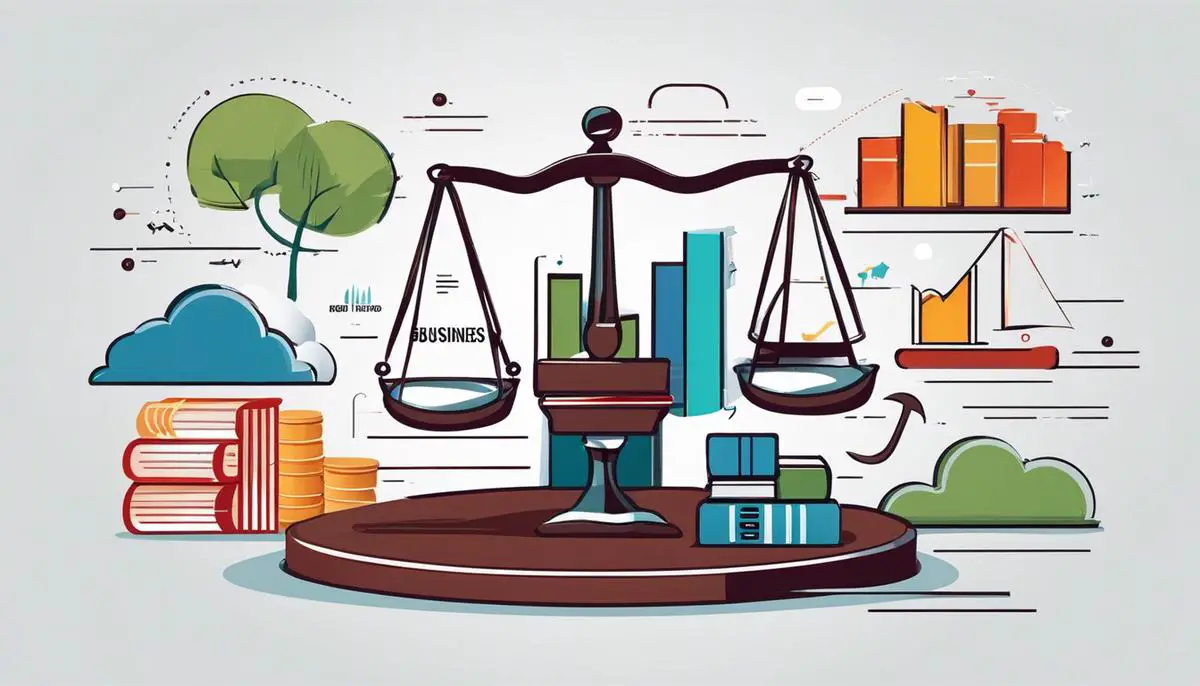In the landscape of business law, torts play an instrumental role as they articulate the concept of wrongful, yet not blatantly criminal, actions triggering legal responsibilities and ramifications. Torts are particularly pertinent to businesses – be they soaring corporations or fledgling startups. They serve to checkmate actions and inactions that could potentially lead to financial loss, damaged reputation, or operational interruption. Much the same as the diversely colored threads tightly integrated into the fabric of our legal spectrum, understanding torts in business law becomes an essential component of navigating the business environment smoothly and successfully.
Understanding Torts in Business Law
In the thrilling world of business, the boundless interweaving of different areas lends itself to a multi-faceted experience that consistently keeps entrepreneurs on their toes. One such area that boasts significant relevance is business law, with emphasis placed on dissecting and understanding the concept of torts. Crucial to the entrepreneurial pursuit of success, mastering the understanding of torts can mean the difference between a booming business venture and a dip into murky legal waters.
A tort, in the simplest terms, is a civil wrong that causes someone else to suffer loss or harm, resulting in legal liability for the individual who commits the tortious act. It’s about enforcing a duty individuals and businesses owe to each other in civil society, to respect each other’s rights and well-being. The seemingly invisible line drawn between lawful operations and legal infringement is determined by torts.
Within the realm of tort law, we discover a maze of subcategories, each one comprehensive and nuanced in its application. We strike gold with ‘Negligence,’ a popular, crucial tort that can happen when an entity fails to use reasonable care, resulting in damage or harm. States keep stringent measures to tackle this problematic issue, which can cascade into catastrophic litigation if handled incorrectly.
But negligence isn’t the sole player here. Enter ‘Defamation,’ the act of causing harm through damaging statements, which can rock corporations to their core. However, the more insidious element is that it doesn’t have to be intentional. By merely spreading false rumors or malicious gossip about a business or individual, one can find themselves answering defamation tort charges.
The spotlight then glares onto ‘Product Liability,’ an area unleashing compelling legal battles. This happens when a manufacturer or business is held liable for placing a defective product into consumers’ hands, jeopardizing their safety. As innovators, it’s crucial to sidestep this pitfall, ensuring meticulous research and development, quality control, and thorough product testing.
Lastly, but by no means less significantly, we find ‘Interference with Business Relations,’ a fascinating tort where unlawfully meddling with a company’s business relationships or contracts can lead to hefty fines and serious damage control.
Understanding the fundamental concept of torts equips one with the knowledge to avoid such breaches, and instead, create flourishing, legally safe business environments. Breaking these down into bite-sized pieces bestows the power of perceptive foresight to tackle or circumvent legal problems before they become monumental.
So, dare to delve into the captivating world of torts. Use the resources available to thoroughly comprehend and apply these fundamental concepts because every successful business endeavor is built on the pillars of knowledge, foresight, and respect for the law. Make the concept of torts in business law your secret weapon to navigate any potential legal quagmire and keep your venture sailing smoothly and profitably.

Different Types of Torts
Delving further into the complex labyrinth of tort law as it applies to the business realm, we’ll explore additional torts commonly encountered, beyond the ones previously discussed – negligence, defamation, product liability, and interference with business relations. Trespass, false imprisonment, and fraudulent misrepresentation also rear their heads frequently, sounding alarm bells for business leaders seeking to navigate the treacherous legal seas safely.
Starting with trespass, an ancient common law concept typically associated with physical property relations, it is also applicable in today’s digital age. Unwarranted invasion of virtual territories – websites, data servers, or online networks – can constitute trespass. Cybersecurity breaches fall into this category, and businesses must take measures to fortify their digital assets against this potential legal threat.
Next, we have false imprisonment, which may seem unlikely in a business context, but think again. Typically associated with personal detention without lawful authority, it also applies to businesses. If a consumer is unduly restrained within a business establishment or coerced into a product agreement, the business could face serious legal repercussions for false imprisonment. Businesses need to ensure they respect their consumer’s rights and promptly address any complaints to prevent such legal pitfalls.
Then, we come across fraudulent misrepresentation, a term that frequently haunts boardroom discussions. It refers to a business conveying false information knowing it to be untrue or without belief in its truth, intending to deceive customers, investors, or other businesses. It could relate to a product, service, or financial information, essentially anything capable of swaying decisions to the business’s advantage.
For instance, making dubious claims about a product’s features or falsely inflating a company’s financial growth to attract investors could invite a lawsuit for fraudulent misrepresentation. Businesses should foster transparency and honesty to combat potential legal complications from this tort.
Moreover, a distinctive offshoot of fraudulent misrepresentation is false advertising, a statutory tort challenging businesses in the consumer markets. Under Truth in Advertising Laws, businesses providing misleading or false information about products or services face severe legal consequences. Embracing truth in advertising not only prevents legal backlash but also bolsters consumer confidence and brand reputation.
Circling back to original concepts borrowed from physical interactions, conversion is another tort exhibiting versatility in its application. It occurs when a person intentionally interferes with personal property belonging to someone else, depriving them of possession or use. In the business realm, conversion might involve unauthorized usage or possession of proprietary information, trade secrets, and intellectual property. Safeguarding valuable business assets with legal protections can nip this risk in the bud.
Indeed, the business landscape is laden with legal hazards. However, armed with a thorough understanding of the different types of torts and proactively deploying protective strategies, businesses can effectively steer clear of these potential landmines, ensuring smooth operations and sailing toward success. Remember, fortifying a business legally is as crucial as strategizing its financial growth. It promotes longevity, sustainability, and reputation – the bedrock of a thriving business venture.
Effects of Torts on Business Operations
Trespassing law, once primarily concerned with physical property boundaries, has evolved significantly in the digital age. Now, it extends its protective reach to intellectual property, data privacy, confidential business information, and digital assets. These measures protect businesses from unauthorized access or infringement on both tangible and intangible property, ensuring the safeguarding of crucial business resources.
In business, false imprisonment may not necessarily take on its traditional physical connotation. It can take the form of a business restricting the freedom of its customers or employees via deceptive methods or violating personal rights. Awareness of this aspect of tort law is instrumental in avoiding potential pitfalls and maintaining a legally sound operational environment.
Business transactions are built on trust. Conversely, fraudulent misrepresentation can shatter this trust, leading to detrimental outcomes for businesses. This tort involves intentionally deceiving another party in a business transaction, potentially leading to significant financial and reputational consequences. Businesses need to uphold transparency and honesty, not only from a legal standpoint but for maintain their reputation and consumer goodwill.
False advertising, a subset of fraudulent misrepresentation, is yet another critical tort that businesses must monitor vigilantly. It challenges the fundamental principle of business – transparency. Whether a business exaggerates certain features of a product or makes unsubstantiated claims, the legal consequences of false advertising can be substantial. It underscores the importance of authentic information and responsible marketing practices.
Last, there’s a less-known tort – conversion – which is vital in safeguarding business assets. When an entity wrongfully possesses or uses another’s property without consent, it’s considered a “conversion” tort. Quite timely in the digital era where intellectual property theft or misuse is rampant, understanding and applying conversion law can deter potential threat actors and protect businesses’ tangible and intangible assets.
In conclusion, while torts pose potential risks to businesses, they’re much more of a protective shield when understood and approached correctly. Solid knowledge of these legal nuances ensures operational smoothness and legal safety, a prerequisite for business success in the marketplace’s dynamic and competitive landscape.
Successful entrepreneurs understand that innovation isn’t solely about product enhancements or service upgrades; it extends to innovating strategies to stay ahead of potential legal ramifications and ensure smooth business operations. It’s not just about playing the game; it’s about knowing the rules like the back of your hand. So, go ahead—equip your business with the shield of legal knowledge and let innovation drive your success!

Legal Remedies For Torts
Advancing to the pinnacle of business success demands more than just innovative products and outstanding services; it requires comprehensive knowledge about the legal landscape that governs your business operations, particularly the realm of tort laws. This awareness breeds a proactive approach to confront and resolve legal objections, cultivating a reputation for integrity and responsibility. Enter the arena of legal remedies – your way to fight and soothe the sting of business-related torts.
Intrinsically, legal remedies focus on righting a wrong or compensating for harm caused by an unlawful act. They serve as the mechanisms through which the court enforces a right to impose a penalty or sanctions behavior in tort law. The most common legal remedies for torts are compensatory damages, punitive damages, nominal damages, and injunctions.
Compensatory damages are the frequently awarded remedy aimed at making the injured party ‘whole’ again. In a business context, an enterprise found guilty of a tortious act might need to reimburse for losses including medical costs, lost wages, property damages, pain and suffering, as well as potential future losses.
Punitive damages take a step further. They’re designed not only to compensate the victim but also to punish the offending entity and deter others from committing similar acts. For example, a company that knowingly produces a dangerous product and fails to provide adequate warnings might be held liable for punitive damages.
Nominal damages are symbolic, a small financial award given when a tort has been committed and rights infringed, but no substantial damage resulted. It’s often leveraged when business relationships become sour due to perceived wrongdoing, even if there isn’t a tangible financial loss.
Lastly, injunctions may grant reprieve. This remedy involves a court order that directs somebody to do – or refrain from doing – a specific act. Consider a situation where a business is accused of causing noise pollution; an injunction could mandate the enterprise to discontinue the noise-causing activity.
It should be reiterated, that it is not the existence of torts but the resolution processes and the effective utilization of legal remedies that foster a culture of accountability. It stresses the point that knowing the law isn’t simply checking a compliance requirement box, it is playing to the tune of success in a challenging symphony that is the business environment.
Legal remedies for torts in business law aren’t just the means of surviving past mishaps; they are tools for constructing a robust business blueprint that can withstand future upheavals. Entrepreneurs ought to explore and understand them as integral parts of their business strategies. By doing so, business leaders ensure that they navigate legal challenges like a seasoned captain steering the ship through a storm toward brighter horizons. That, after all, is what the entrepreneurial journey is all about. Navigating the business world is no smooth sailing, but with the rudder of legal remedies, you’re prepared to overcome stormy waters.
Preventing Tort Risks in Businesses
Having established an in-depth understanding of the breadth and depth of tort law, one would need to harness this knowledge to create a foolproof business operation. A key strategy to prevent the risk of torts within a business context involves comprehensive and regular professional education about the changing dynamics of business law.
The business world is highly dynamic with disruptive technologies and evolving customer needs necessitating constant innovation, while outdated regulations are frequently being replaced or modernized. To prevent torts, businesses must stay at the forefront of these changes, ensuring that they are not only informed about but are well ahead of the curve. This requires a continuous investment in employee education programs and a commitment to creating an adaptive business culture.
On another level, businesses must foster ethical practices and enhance their decision-making processes to minimize the risk of engaging in legally compromising activities. They need to cultivate a transparent, honest work environment where clear communication and respect for individual and corporate rights are valued above all. This can be achieved through comprehensive training on business ethics and fostering an organizational culture that encourages adherence to legal standards and norms.
Insight into legal remedies in tort law is also of paramount importance. It involves understanding what measures exist for redressing a wrong. Remedies are laws in place to restore the victim or claimant of a tort to their position before the tortious activity, recognizing the harm done to them. Understanding these remedies allows businesses to appreciate the full potential implications of their actions and decisions, thus, guiding more informed and legally sound decisions.
Fully appreciating these remedies, we examine compensatory damages which are designed to place the injured party back in the position they would have been absent the tort. This often takes the form of financial compensation for losses incurred. Punitive damages, on the other hand, purposefully go beyond compensating the victim, intending to punish the offending party for their actions and deter others from similar conduct.
Nominal damages serve as a symbolic recognition of rights that have been infringed upon, even if no actual monetary loss has transpired. Then there are injunctions, a potent legal tool used to demand or prevent specific actions. These dictate the conduct of the offender, preventing potential future harm. An understanding of these remedies serves to emphasize the importance of ethical conduct and legal observance for smooth business operations.

Conclusion
In conclusion, the prevention of torts is a multi-faceted practice. It calls for regular professional education, ethical and transparent business practices, and a deep understanding of legal remedies. By adopting these measures, businesses can greatly minimize the risk of tortious conduct, ensuring operational smoothness, legal safety, and ultimately, business success.
Vigilance and proactive strategies are crucial to shield against potential tort risks in the business hemisphere. Making deliberate efforts towards instilling a robust culture of ethics, creating airtight contracts, setting up stringent workplace guidelines, and conducting regular legal audits are some of the key measures businesses can deploy. It is essential to remember that the law is both an ally and a strict taskmaster, and when navigated with acumen and prudence, it ensures that businesses run smoothly. As businesses evolve, so should their understanding and approach toward maintaining their legal sanctity, ensuring they stand the test of time in the challenging business environment.








